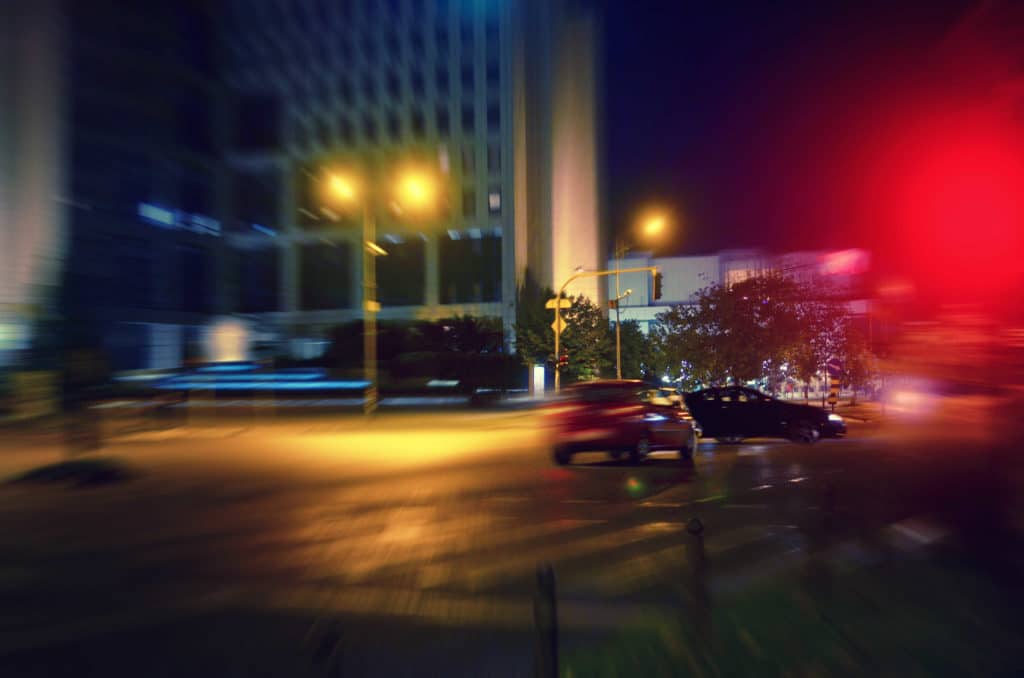At night, drivers are 3X more likely to be involved in a fatal car accident than when driving during the day. Driving at night means that you are less likely to see things coming at you due to low visibility. You may also be temporarily blinded by oncoming traffic. As the holiday approaches, more people will be on the road. Knowing how to drive at night will help people avoid car accidents, but it will also make the road safer for everyone.
You may consider using defensive driving techniques while focusing on the road as well. Follow these tips for driving in the dark to ensure you get to your destination safely.

1. Aim Your Lights
At times, headlights are uneven or pointed too low. You can aim your lights on your own following the instructions in your manual. Most car headlights can be adjusted by simply removing the screws that mount your headlight to the frame of your car. According to one smart mechanic, you should: “Open the hood.
There are mounting screws and adjustment screws above, below, and to the side of the headlight. Park your vehicle 25 feet from a wall, and place a piece of tape horizontally 4 feet high across the wall in front of your vehicle. Turn on the low beams. Adjust the headlights until they shine on the tape.”
If you don’t want to do it yourself, you can take your car to a mechanic and have it done for you. If you are driving an older car, buy a headlight polish kit and remove the haze that has built up on the covers. Just like the rest of these tips for driving in the dark, be careful not to overdo it! You must not over-angle your headlights because you could affect the vision of other drivers around you.
2. Dim the Panel
Ever notice how the interior lights of your car will brighten when you shut off your headlights? That’s because your interior lights are set to dim when you’re driving at night, and if you turn on your headlight, you are assumed to be driving at night or at least in conditions of limited visibility.
Most cars come with the ability to dim the interior lights. If your dashboard is lit up like a runway, it could be compromising your vision. Turn down the dashboard lights to a readable, but low level.
Fun fact, we all probably grew up with our dad or mom telling us to turn off the interior lights of the car if we ever put them on. Interior lights will affect your ability to see clearly at night, so your parents were right. Be sure to keep them off!
3. Avoid Glasses
Naturally, you should wear your prescription glasses when you drive, but you should avoid glasses sold for night driving in most cases. There are yellow-lensed glasses that are marketed to the public, telling them they will see better at night.
The reality is that these glasses reduce the amount of light you can see. If you have a prescription, ask for an anti-reflective coating to be applied to your lenses. This keeps light from bouncing and helps you see better. Even better, wear contacts instead of glasses if possible.
Of course, this is one of those tips for driving in the dark that you may not be able to follow. If that’s the case, keep your glasses on! We would rather you have full vision!
4. Shiny Eyes
Keep your own eyes open for other pairs of eyes on the road! You can often spot animals in or near the road when your lights hit their eyes. If you see the telltale sign of shiny spots near the roadway, slow down immediately. If you wait to hit the brakes until you get closer, you could very well cause an accident. When you do drive upon a large animal in the roadway, try to brake slowly and stay the course. Swerving is never a good idea.
Almost 200 people are killed in animal-related car accidents every year, while many more are injured.
5. Focus Elsewhere
As we age, oncoming headlights become more bothersome. Do not look into the headlights of an oncoming vehicle. Your eyes have adjusted to the dark, making these lights especially blinding. Try to look somewhere else ahead of you. Focus on the side of the road for a moment until the vehicle has passed. If it is the car behind you that is blinding you with its lights, turn your rearview mirror down.
If you are driving somewhere unfamiliar, be sure to pay extra attention to the street signs and the road. Looking around for street addresses and street signs can be dangerous when driving at night. Your best bet is to use your GPS on your cell phone to guide you through any unfamiliar neighborhoods, while you keep your focus on the road in front of you. This is one of the easiest but often overlooked tips for driving in the dark.
6. Keep a Rag or Cloth Handy
Wipe your windshield down with a piece of cloth or a spare rag if possible. This will remove residue that can cause glare at night. Avoid wiping the inside of your windshield at all costs! All that’s going to do is limit your vision even more.
Those smudges and streaks are going to reflect light and make it even more difficult for you to see where you are driving. If your windshield get’s foggy, turn on your car demystifier or crack a window instead.
Use the rag or cloth exclusively on the exterior window and when in doubt, pull over the gas station to give your windshield a proper wash.
7. Turn On the Fog Lights
If your car is equipped with fog lights, make sure they are turned on. This will help you see changes in the road faster. One thing to keep in mind, though, is that fog lights cast shadows that will make rocks, potholes, and bumps appear larger than they may be.
Fog causes almost 40,000 car accidents every year injuring just over 16,o00 drivers and killing roughly 600 people. It’s important to treat fog just as you would a heavy rain. These
8. Clean Your Mirrors
Dirty mirrors make it difficult to see. Streaked mirrors make the glare of lights worse. A good position for side mirrors is tipped slightly downward. You will have to move your head in a different way to see clearly, but lights will not bounce into your eyes.
9. Get a Vision Screening
Eye doctors recommend keeping your eyes moving to prevent nighttime driving fatigue. They also suggest a checkup at least every two years for adults. Keeping your eyes in tip-top shape is a surefire way to drive more safely at night. Of all the tips for driving in the dark, this may be the most serious and life-changing tip we can give.
Driving after the sun goes down requires a different skill set than driving when the sun is up. It also requires that you make a few changes to your car. When you make sure that your mirrors are clean, your lights are positioned properly, and your interior lights are dimmed, you can be sure to avoid those accidents that can be.
If you are injured in a car accident in West Palm Beach, reach out to our team of experienced accident attorneys. We will review the details of your crash and advise you of the options available to you under current state law. You may be able to seek compensation for property damage, injury, and more. Call now or browse our website for more information about our firm and the types of cases we have handled successfully.

About the Author

Michael Steinger
MICHAEL S. STEINGER, founding partner of Steinger, Greene & Feiner, believes in representing real people, not big businesses. Since the firm’s creation in 1997, Steinger, Greene & Feiner has never represented an insurance company or large corporation, and he vows to keep this promise. Over the course of his career, Michael has handled thousands of Florida accident cases, recovering millions of dollars for his clients and earning him membership into the Multi-Million Dollar Advocates Forum.
Staying up-to-date on the ever-evolving laws protecting injury victims and their families, Michael is an active member of the American Bar Association, the Palm Beach, and St. Lucie Bar Associations, and sits on the Auto Insurance Committee of the Florida Justice Association.

Michael Steinger
MICHAEL S. STEINGER, founding partner of Steinger, Greene & Feiner, believes in representing real people, not big businesses. Since the firm’s creation in 1997, Steinger, Greene & Feiner has never represented an insurance company or large corporation, and he vows to keep this promise. Over the course of his career, Michael has handled thousands of Florida accident cases, recovering millions of dollars for his clients and earning him membership into the Multi-Million Dollar Advocates Forum. Staying up-to-date on the ever-evolving laws protecting injury victims and their families, Michael is an active member of the American Bar Association, the Palm Beach, and St. Lucie Bar Associations, and sits on the Auto Insurance Committee of the Florida Justice Association.
